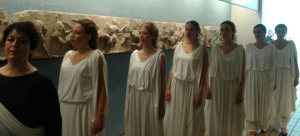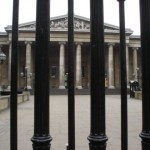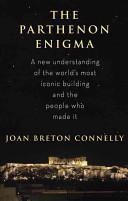JOAN BRETON CONNELLY: “The Parthenon sculptures were not made as stand-alone objects. They were made as part of a building, a building that still stands in the middle of Athens today.
They reflect a people. They reflect a very ancient history. They reflect a religion that can only be understood when put together as a coherent whole. There is a narrative there. It is a story. The story, to be understood deeply and completely, must be brought together again.”
(Partial Transcript from PBS Newshour interview with JOAN BRETON CONNELLY, author of the new book “The Parthenon Enigma.”)
See the 6 minutes video.
TRANSCRIPT
GWEN IFILL: Taking a fresh look at a timeless treasure.
Jeffrey Brown has our book conversation.
JEFFREY BROWN: It’s perhaps the most famous building in the world, the Parthenon in Athens, Greece. Built in the fifth century B.C., it’s become a symbol of the very idea of democracy in Western civilization, as well as an architectural model for other important structures, including the U.S. Supreme Court.
A new book, “The Parthenon Enigma,” tells the story of the people who built it and how it’s been understood, rightly and wrongly, to our own day.
Author Joan Breton Connelly is a classical archaeologist and professor at New York University.
And welcome to you.
JOAN BRETON CONNELLY, “The Parthenon Enigma”: Thank you.
JEFFREY BROWN: Your subtitle refers to the Parthenon as the world’s most iconic building. Ionic in what sense? How do you define what it’s come to mean?
JOAN BRETON CONNELLY: It stands for so much to so many generations of people.
It is a building that is instantly recognizable. It is a building that is endowed with meeting, the birthplace of democracy in particular over the ages, especially the Enlightenment onwards.
It sets the stage for everything that we regard as our highest ideals, perfection in proportion and aesthetics.
JEFFREY BROWN: But your — but your — then your argument is that, in taking all that in, from the enlightenment on, we have somehow missed something. We have missed the Greeks themselves
JOAN BRETON CONNELLY: We got it wrong.
When you’re confronted with an object of beauty, we like to see ourselves in it, reflected glory. But when we try to look at it through ancient eyes, we see a very different reality, a spiritual reality, one with a deep, dark myth behind it.
JEFFREY BROWN: Well, explain that. I mean, first of all, we think of it as a temple of democracy, but what we’re missing is the temple — it was really a religious temple, right?
JOAN BRETON CONNELLY: It involves the foundation myth of Athens itself, the first king and queen of Athens and how, when the first barbarian hordes came and surrounded the Acropolis, they went to the Delphic oracle and they said, how can we save our army?
And the oracle demands that their virgin daughter be sacrificed. And so they give the ultimate sacrifice for the saving of the city. This is extraordinary against the backdrop of their own times. That is the notion that the most elite people in the city, the royal family itself, would make the sacrifice, so that their people could survive.
JEFFREY BROWN: So human sacrifice, of course, doesn’t go very well with contemporary values.
JOAN BRETON CONNELLY: Absolutely.
And it’s disarming to see that what we look to as the icon of democracy might have above its door a scene of human sacrifice. But this is a metaphor for what the Athenians valued most. And what is important here is that their notion of democracy had at its core the idea of the common good.
Individual interests were fine. We talk about them a lot today, but the building blocks, the spiritual core of Athenian democracy was this notion of a common good.
JEFFREY BROWN: Scholars like yourself have been looking at this for a long, long time, right? What’s interesting in reading here is that it’s always interpreted through our own time, anybody’s contemporary time.
JOAN BRETON CONNELLY: This is very understandable. It’s completely human to see yourselves in the past.
The most basic human question is, where do I come from? And you want to find yourself the past. So I don’t have a problem with that. It’s just that we have got new data. And when new data emerges, this data changes our old ideas and assumptions.
JEFFREY BROWN: What has changed in the last decades that we know more now?
JOAN BRETON CONNELLY: Well, for starters, for the past 30 years, the Acropolis restoration program has undertaken this complete renewal of the Acropolis, taking down the building block by block, cleaning, laser-scanning, looking at every angle of the blocks, and then putting them back up together.
So this has given us an enormous amount of new information about how the building was built. Secondly, we have the new papyrus that I set forth this book that is a lost play by Euripides, which was known, but for which we had very few lines, until the 1960s, when a mummy in Paris that had been excavated in Egypt in 1901 finally…
JEFFREY BROWN: It’s quite a detective story, actually, isn’t it?
JOAN BRETON CONNELLY: It is a real detective story…
JEFFREY BROWN: Yes.
JOAN BRETON CONNELLY: … building on one discovery, the discovery of a French archaeologist in 1901, and then the breakthrough of a French papyrologist in the 1960s of how to peel the layers of papyrus off of the mummy, cartonnage, that is the hard papier-mache casing around the mummy itself.
This yielded new texts. This text tells us the story of the first king of Athens and his family.
JEFFREY BROWN: There’s an ongoing debate, of course, about whether the friezes, the sculptures that are in the British museum and elsewhere should be returned to Athens, where there’s been a new museum built for them. You think they should be. Why is that important?
JOAN BRETON CONNELLY: The Parthenon sculptures were not made as stand-alone objects. They were made as part of a building, a building that still stands in the middle of Athens today.
They reflect a people. They reflect a very ancient history. They reflect a religion that can only be understood when put together as a coherent whole. There is a narrative there. It is a story. The story, to be understood deeply and completely, must be brought together again.
JEFFREY BROWN: OK. The new book is “The Parthenon Enigma.”
Joan Connelly, thanks so much.
JOAN BRETON CONNELLY: Thank you.
(source: PBS Newshour 06February 2014)




Recent Comments